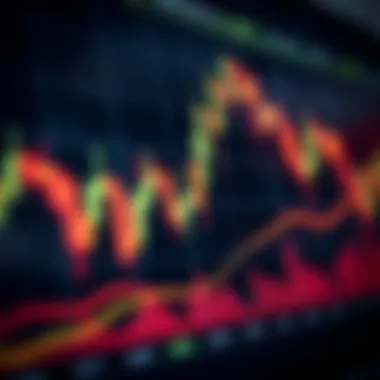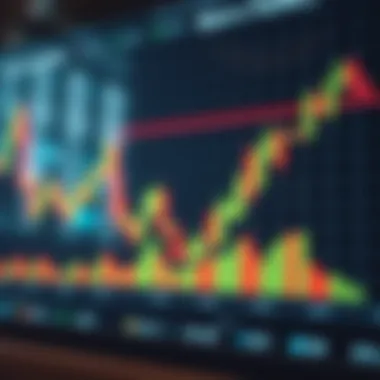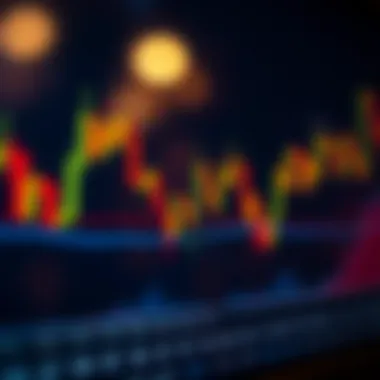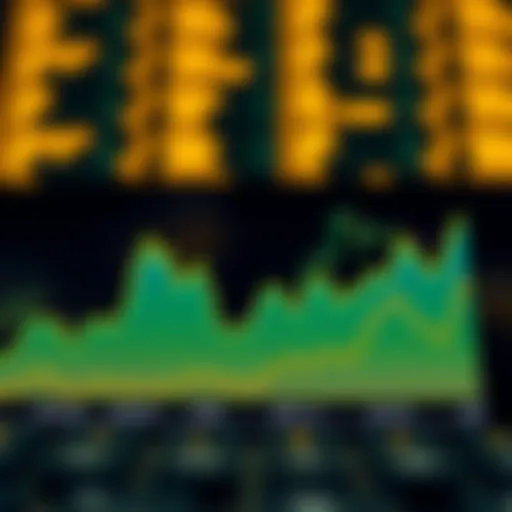Mastering Candlestick Charts for Traders and Investors


Intro
Candlestick charts are not just pretty visuals cluttering the screens of day traders; they are pivotal tools in understanding the ebbs and flows of financial markets, especially in the world of cryptocurrency. These charts, which have stood the test of time since their inception in Japan in the 18th century, encapsulate vital price information through a simple yet powerful format. The colors, shadows, and bodies of the candlesticks tell a story about buyer and seller dynamics, market sentiment, and potential future movements.
In this guide, we will peel back the layers of candlestick charts, dissect their essential components, and explore how to interpret these patterns effectively. Whether you are just starting your journey into cryptocurrency trading or looking to sharpen your existing skills, understanding candlestick patterns will bolster your market analysis capabilities and enhance your investment strategies.
As we venture through the intricacies of candlestick analysis, you will learn to recognize established trends, predict price movements, and craft strategies that suit your investment style. It's not just about reading patterns; it's about deciphering the market’s language and leveraging that knowledge to inform your decisions. Let’s pull back the veil on candlestick charts and see how they can transform your trading approach.
Market Analysis
Current Trends in Cryptocurrency
The cryptocurrency realm is constantly in flux, with trends shifting as swiftly as the wind changes direction. Staying ahead of the game requires a clear grasp of current market dynamics. One can analyze price movements and sentiments through candlestick charts and identify emerging trends. For instance, the predominance of bullish or bearish candlestick formations can signal whether traders are optimistic or pessimistic about a particular digital asset's future.
Moreover, keeping an eye on major events influencing the market, such as regulatory news or technological advancements in blockchain technology, is crucial. These factors often manifest in candlestick patterns, giving traders the ability to respond rather than react. When assessing current trends, recognize the following key indicators:
- Volume spikes: High trading volume often correlates with market moves.
- Support and resistance levels: These are points where price trends tend to reverse or stall.
- Market sentiment indicators: Utilize social media platforms, like Reddit and Twitter, to gauge the mood of retail investors.
By integrating these indicators within the analysis of candlestick patterns, you can create a well-rounded view of the market's landscape.
Price Prediction Techniques
Predicting price movements in cryptocurrencies can feel akin to playing a game of chess; one wrong move can set you back significantly. Yet, through understanding candlestick chart patterns, the journey becomes clearer.
A few proven techniques for price prediction include:
- Utilizing candlestick patterns: Recognizing formations such as Dojis, Hammers, and Engulfing patterns can yield insights on potential market reversals or continuations.
- Applying moving averages: These help in smoothing out price data, making it easier to spot trends over specific periods.
- Implementing indicators: Tools such as the Relative Strength Index (RSI) and Moving Average Convergence Divergence (MACD) complement candlestick analysis by providing a broader assessment of price momentum.
Using a combination of these techniques can lead to a sharper forecasting capability, empowering you to make confident decisions.
Investment Strategies
Long-Term vs Short-Term Investing
The age-old debate of long-term versus short-term investing continues to reverberate in the crypto community. Each approach has its merits, and understanding your investment goals is vital in determining which path to tread.
- Long-Term Investing: This method, often likened to planting a seed and waiting for it to mature, requires patience. Investors hold onto cryptocurrencies for several months or years, banking on the appreciation of value over time. Candlestick charts can help identify entry points, but the focus lies in the bigger picture, often considering overall market trends.
- Short-Term Investing: Short-term strategies, including day trading, seize opportunities for quick profits. Traders analyze candlestick patterns for cues on immediate price movements. This strategy requires a keen eye for detail and quick decision-making.
In the end, the choice between these two strategies hinges on individual risk tolerance and market outlooks.
Risk Management in Crypto Trading
Every seasoned trader knows that effective risk management is fundamental in the perilous waters of cryptocurrency trading. Here are some tactics to consider:
- Setting stop-loss orders: By predetermining the price at which you will exit a losing trade, you can cap potential losses.
- Diversifying your portfolio: Don’t put all your eggs in one basket; allocate funds across various assets to mitigate risk.
- Position sizing: Determine how much capital to risk on each trade to avoid catastrophic losses.
Maintaining a disciplined and strategic approach to trading allows you to navigate the volatility of crypto markets effectively.
"Risk management is what separates the successful trader from the rest."
Through careful analysis, solid strategies, and a rigorous understanding of candlestick charts and market dynamics, you put yourself in a position to thrive in the unpredictable world of cryptocurrency trading.
Preamble to Candlestick Charts
Candlestick charts are a cornerstone in technical analysis, especially for traders looking to navigate the often turbulent waters of financial markets. Understanding these charts is not just about recognizing shapes; it’s about uncovering the psychological undercurrents that drive market movements. From investors looking to make data-driven decisions to analysts dissecting market trends, candlestick charts serve as a beacon allowing users to predict potential price movements.
The significance of mastering candlestick charts lies in their ability to encapsulate data visually. Unlike traditional line charts that offer a one-dimensional perspective, candlestick charts provide a multi-faceted view of price movements. Each candlestick encapsulates four critical pieces of information: the opening price, closing price, and the day's high and low prices. This rich data allows traders to gauge market sentiment quickly.
Historical Background of Candlestick Charts
The roots of candlestick charting trace back several centuries to Japan, specifically to the 18th century. Initially utilized by rice traders, these charts were developed by Munehisa Homma, who recognized a correlation between price movements and market psychology. This approach was revolutionary at the time, as it shifted focus from mere price to the behavior and emotions of market participants.
As trade and commerce evolved, the practice migrated to the West, particularly in the late 20th century. Today, candlestick charts have found their way into various assets beyond rice; they are now essential in analyzing stocks, currencies, and cryptocurrencies alike. Understanding this historical context provides valuable insight into why candlestick patterns are so effective in predicting future price behavior—they're steeped in a time-tested methodology of human psychology.
Why Candlestick Charts Matter in Trading
Candlestick charts matter because they distill complex market information into easily digestible visual signals. Traders can identify trends and reversal patterns, helping them make informed decisions. For instance, a long bullish candle could signal strong buying interest, while a small bearish candle may suggest indecision in the market.
Moreover, they can be a trader’s best friend when it comes to navigating volatility— a common feature in today's fast-paced markets. By recognizing specific patterns, traders can make decisions not just based on speculation, but grounded in analysis.
"In trading, the trend is your friend until the end when it bends."
This highlights the importance of being able to read candlestick signals effectively. In times of rapid price swings, effective use of candlestick charts can aid traders in distinguishing between a short-lived uptrend and a more sustainable market shift.
In summary, the introduction to candlestick charts sets the foundation for a more nuanced discussion on their structure, patterns, and strategic applications. It allows traders, analysts, and tech enthusiasts to dive deeper into market trends with a solid grounding in historical context and modern relevance.
Understanding the Structure of Candlestick Charts
Understanding the structure of candlestick charts is like getting familiar with the bones of a body before diving into its complexities. It’s vital for any trader or investor looking to decipher market behaviors and trends. The ability to spot nuances in these charts can help you read the sentiment and volatility of the market, operational insights that are crucial for making informed decisions.


Candlestick charts essentially provide a visual narrative of price movements over a specific timeframe. When you grasp their structure, you can identify trends, reversals, and potential points of entry or exit in your trading strategy. Whether you are dipping your toes into trading or are a seasoned market player, the foundation laid by understanding these charts can dramatically influence your performance.
The Anatomy of a Candlestick
Open Price
The open price is the ground zero of a candlestick, marking where the price action begins for a particular time period. This point sets the stage for whatever follows: buyers and sellers alike react to the open, influencing the subsequent price dynamics. It’s this very price that helps you determine the bias of traders at the start of that period. A benefit of tracking open prices lies in forming comparisons; observing how these compare to the close price can help you gauge market sentiment. However, if you only focus on the open price, you might miss broader market context, potentially leading to skewed interpretations.
Close Price
The close price is the finale of the candlestick, revealing whether the price concluded higher or lower than it opened. This price carries significant weight in trading analysis, as it reflects the consensus value at which buyers and sellers agreed. Traders often consider the close price more prominently than the open since it indicates whether a bullish or bearish sentiment prevailed. Nevertheless, relying solely on close prices can sometimes obfuscate interim volatility, which could lead to missed opportunities or misguided trades.
High and Low Prices
High and low prices function as the peaks and valleys of the candlestick, showcasing the extremes reached during a trading period. The high represents the highest price achieved, while the low indicates the lowest. This range is indispensable, revealing market volatility and allowing traders to set key levels for stop losses or target profits. Understanding these extremes enhances the overall picture by indicating not just where price ended up, but how much fluctuation occurred. Ignoring the highs and lows might lead to a simplistic view that fails to account for potential market swings and risks.
Colors and Their Meaning
Bullish Candlesticks
Bullish candlesticks are the green knights of the trading realm, signifying optimism and potential upward movements. When you see a bullish candlestick, it indicates that the close price was higher than the open price, suggesting that buyers were in control during that period. This positivity can serve as a beacon for traders looking to capitalize on upward trends. However, relying solely on the appearance of bullish candles can mislead, especially amid high volatility or market corrections.
Bearish Candlesticks
Conversely, bearish candlesticks paint a more pessimistic picture. They emerge when the close price is lower than the open price, indicating that sellers dominated that trading session. These candles can serve as warning signals, suggesting potential downtrends. It’s important to appreciate their context, as one isolated bearish candlestick might not warrant panic if it appears in a broader uptrend. Thus, while they are significant, they should be evaluated in tandem with market sentiment and key levels.
"Understanding the nuances within each candlestick goes beyond just price; it’s about discerning the market's psychological ebb and flow."
Using this detailed knowledge of individual candlestick components—open, close, high, low prices, combined with the meanings of their colors—gives traders a more nuanced perspective. This understanding can dramatically increase the likelihood of identifying actionable trading opportunities.
Reading Candlestick Patterns
Reading candlestick patterns is crucial for any trader looking to navigate the complex landscape of financial markets. These patterns function as visual cues, offering insights into potential market movements. By understanding these formations, traders can make more informed decisions about when to enter or exit a position.
The benefits of mastering candlestick patterns extend beyond just visual tracking of price action. They help in cultivating a deeper understanding of market psychology, revealing the emotional states of buyers and sellers. An investor can draw valuable conclusions about market sentiment when they recognize certain patterns in real time. Documenting this knowledge helps in constructing strategies aligned with observed trends, ultimately leading to better risk management.
Single Candle Patterns
Single candle patterns are the simplest yet powerful indicators in the world of candlestick analysis. Each candle reflects a specific period's price action, and by interpreting single patterns, traders can extract useful information about potential market reversals and continuations.
Doji
The Doji is a unique candle characterized by its minimized body, typically forming when opening and closing prices are nearly the same. Its significance lies in its representation of indecision in the market. This indecision can result in traders being at a crossroads, often signaling a potential shift in trend direction. Traders frequently look out for Doji candles at key support or resistance levels, adding to their strength as a reversal indicator. Their benefits in signaling potential market turns cannot be overstated, but it’s essential to consider the context in which they form.
Hammer
The Hammer pattern, recognizable by its small body at the upper end and a long lower wick, suggests that buyers are pushing back against selling pressure. This candle typically appears after a decline, acting as a potential signal for reversal. Its key characteristic lies in its ability to indicate that the bearish sentiment may be waning. However, it's vital not to overestimate its strength without confirmation from subsequent price movements. While the Hammer can be a powerful signal, it may also lead traders astray if misinterpreted as a definitive buy signal without other confirming indicators.
Shooting Star
Conversely, the Shooting Star pattern embodies potential bearish reversal after an uptrend. It sports a small body at the bottom with a long upper wick, suggesting that buyers initially drove prices higher, but sellers eventually took control. This structure can often induce caution among bullish traders. As a result, the Shooting Star serves as an alert, signaling that one should reconsider entering a long position in hawkish conditions. While it’s a useful indicator, its reliability is bolstered significantly by its timing and position relative to previous candlestick actions.
Multiple Candle Patterns
Multiple candle patterns leverage the interaction of two or more candles to provide a clearer context for market movements. These patterns help traders gain a more substantial grasp of trends, making them invaluable in decision-making.
Engulfing Patterns
Engulfing Patterns come in two types—bullish and bearish. A bullish engulfing occurs when a smaller bearish candle is followed by a larger bullish candle, suggesting a shift in market sentiment toward buying. It acts as a robust confirmation for those looking to go long. The opposite is true for a bearish engulfing pattern, where a bullish candle is followed by a more substantial bearish candle. These patterns can provide opportunistic entry points but carry the caveat of needing to assess market context effectively to avoid false signals.
Morning Star
The Morning Star is a three-candle pattern that signals a potential reversal from a downtrend to an uptrend. It consists of a long bearish candle, followed by a smaller-bodied candle, and then a long bullish candle. The presence of this formation provides a strong indication of increased buyer interest after selling pressure has waned. Its primary advantage lies in its ability to capture traders’ attention as a reliable reversal signal, prompting them to reset their positions accordingly.
Evening Star
In contrast, the Evening Star is the bearish counterpart to the Morning Star and indicates a potential decline from an uptrend. This three-candle configuration consists of a long bullish candle, followed by a smaller-bodied candle, and a long bearish candle. It captures the essence of shifting trends, making it a reliable marker for traders looking to sell. The Evening Star's value lies in the visual representation of this trend change, yet, like other patterns, ensuring confirmation through volume and other indicators is vital for success.
In summary, recognizing and interpreting candlestick patterns can elevate a trader's ability to read market sentiment and optimize their strategies effectively. The precision lies not just in spotting these patterns but also in understanding the contextual backdrop they emerge from.
Advanced Candlestick Analysis Techniques
Understanding candlestick charts is just the tip of the iceberg. To truly master this tool, one must delve into advanced candlestick analysis techniques. This section emphasizes how layering additional analytical tools and concepts can yield a nuanced edge in trading. It's not simply about drawing lines on a chart or counting formations, but integrating various elements that can influence trading decisions.
Combining Candlestick Patterns with Other Tools
To gain a more comprehensive view of market movements, it's crucial to combine candlestick patterns with other analytical tools. Each tool offers unique insights, paving the way for more informed trading.
Trend Lines
Trend lines are fundamental in any trading strategy. They serve as visual indicators that outline the general direction of price movement. A key characteristic of trend lines is their ability to reflect both support and resistance levels, revealing potential turning points in the market. Traders often favor these lines because of their straightforward nature and the clarity they provide in identifying trends.


However, trend lines can have disadvantages. For instance, they are subjective. Different traders might draw them differently based on their perspectives, thus leading to varied interpretations of the same chart. Misplaced lines can potentially mislead traders into false conclusions, so precision in drawing these lines is vital.
Moving Averages
Moving averages are another staple in technical analysis. They smooth out price data to identify the underlying trend more clearly. The moving average serves as a lagging indicator, meaning it reacts to price changes rather than predicting them. Its key characteristic is simplicity; it blends multiple data points into a single line, which can reduce noise in volatile markets.
These averages come in various forms, such as the simple moving average and the exponential moving average. The unique aspect of using moving averages is their versatility; they can be employed to determine entry and exit points, alongside confirming current trends. However, a downside is their lagging nature; they may miss sudden price shifts, thus delaying trading decisions if one solely relies on them without real-time context.
Volume Analysis
Volume analysis focuses on the number of shares or contracts traded in a given period and is essential for validating price movements. The key characteristic of volume analysis is its ability to provide context; a price change accompanied by high volume is often more significant than one with low volume. This correlation can help traders discern whether a trend is strong or merely a blip in the market.
The unique feature of volume analysis is its predictive capability. By observing volume spikes, traders can gauge potential market shifts before they materialize. But there's a catch—anomalies in volume can occur due to various factors unrelated to market sentiment, such as news releases or institutional trading. Therefore, it's crucial to analyze volume in conjunction with other indicators to avoid potential pitfalls.
Probability and Market Psychology
Diving into the psychological facets of trading can be just as important as numbers and patterns. Probability in trading refers to the likelihood of price action based on historical data. Traders often rely on statistical measures to formulate expectations about market behavior.
Market psychology, on the other hand, involves understanding trader sentiment, emotions, and behaviors. It's said that emotions can often sway trading decisions more than actual data. Being aware of these psychological factors can position traders advantageously as they can better anticipate market reactions.
Incorporating advanced analysis techniques into candlestick trading enhances one's understanding of market dynamics. By marrying patterns with other analytical tools, you can cultivate a comprehensive view that clarifies the complexity of financial markets.
Developing a Trading Strategy Utilizing Candlestick Charts
Developing a trading strategy around candlestick charts is crucial for anybody serious about navigating the often-turbulent waves of financial markets. This section dives into the importance and benefits of utilizing candlestick charts in your trading arsenal, emphasizing how they can support the decision-making process.
Importance of Candlestick Charts in Trading Strategy
Candlestick charts not only present price data in a visually engaging way but also encapsulate market sentiment and behavior. When you grasp a candlestick's structure and pattern, you're essentially holding a mirror to the market's psychology, which is invaluable in making informed trading decisions.
Traders hinge their strategies on identifiable behaviors. For example, if a series of bullish candlesticks appear, you might consider it a signal for potential upward movements, while a string of bearish candles might raise a red flag. The objective is to harness this visual information effectively to drive trading outcomes.
To construct a winning strategy using candlestick charts, consider how patterns can overlap with other indicators such as moving averages or Fibonacci retracements. This integrated approach strengthens your analysis, providing a multi-faceted view of price action.
Setting Entry and Exit Points
Deciding when to enter or exit a trade is akin to dancing a delicate waltz—wrong steps can lead to slips. Candlestick analysis helps clarify these movements:
- Identifying Entry Points:
- Establishing Exit Points:
- Look for specific patterns that suggest upward momentum, like a bullish engulfing pattern or a hammer. These signals can provide you with tangible indicators to time your entry precisely.
- Pay attention to support levels indicated by previous low candles. The concept here is straightforward; entering near robust support could shield your investment from sudden dips.
- Use bearish patterns to identify potential reversals, ensuring you lock in profits before a market downturn.
- Setting targets based on previous highs or Fibonacci levels can provide structure to your exit strategy and help minimize emotional trading.
A well-thought-out entry and exit strategy based on candlestick analysis not only mitigates risk but also improves overall trading efficiency.
Risk Management Techniques
In the ever-volatile realm of trading, risk management is a non-negotiable element of any robust strategy:
- Stop-Loss Orders: These should be based on candlestick formations. For instance, placing a stop-loss just below a recent low (if you're buying) helps protect against excessive losses should the market move against you.
- Position Sizing: This principle aligns perfectly with your analysis of candlestick signals. If the market presents a strong bullish pattern, consider adjusting your position size to leverage the opportunity without overextending.
- Diversification: Avoid putting all your eggs in one basket. A mix of assets, analyzed via different candlestick patterns, spreads the risk and potentially increases your chances of a favorable outcome.
Utilizing these risk management techniques in conjunction with candlestick chart analysis creates a layered defense against the unpredictable nature of trading.
"Investing without a plan is like sailing without a compass; you might end up anywhere but where you intended."
In summary, by integrating the insights gained from candlestick patterns with carefully defined entry, exit, and risk management strategies, traders can enhance their ability to survive and thrive within financial markets. This methodical approach not only underscores your trading philosophy but also allows you to adapt and evolve with market dynamics.
For further reading and resources, consider visiting Investopedia or check Wikipedia's guide on Technical Analysis.
Engaging with forums like Reddit's trading community can also provide practical advice and shared experiences from fellow traders.
Common Mistakes to Avoid When Reading Candlestick Charts
Understanding candlestick charts is pivotal for any trader aiming to navigate the intricate world of market analysis. However, misreading these charts can lead to mistaken conclusions and suboptimal trading decisions. This section sheds light on some common pitfalls traders often encounter, aiding your quest for a more knowledgeable and effective trading practice.
Misinterpretation of Candlestick Signals
Candlestick patterns are rich in nuance; they tell a story about market sentiment. A frequent stumbling block is misinterpreting the signals that these patterns convey. For example, a Doji signifies indecision, yet a novice might take it as a confirmation of a reversal without extra evidence. Rushing to conclusions prevents assessment of broader market conditions. Often, an isolated candlestick fails to reflect what’s brewing beneath the surface.
Consider the following:
- Contextual signals. Indicators such as volume, market trends, and other candlestick patterns should complement your readings. Jumping the gun without holistic evaluation can cost you dearly.
- Multiple confirmations. It’s riskier to act on a lone candlestick pattern. Always seek corroboration through various indicators, such as trend lines or moving averages.
It’s crucial to remain level-headed among the noise.
“In trading, it's not about what you know; it's about how well you understand what you see.”
Ignoring Market Context


Market context is often an overlooked aspect when scrutinizing candlestick charts. Traders sometimes become fixated on a pattern while completely disregarding external economic factors. For instance, a bullish pattern might appear promising, but if it unfolds during a broader market downtrend or amid uninspiring economic news, the implications can change drastically.
When analyzing candlestick charts, remember:
- Economic indicators. Keeping an eye on reports such as the Consumer Price Index (CPI) or employment figures can inform your candlestick interpretations significantly. They might provide material insights into market movement and sentiment.
- Market sentiment. Pay attention to news events or geopolitical developments. They can swing bullish signals right into bearish territory real quick, proving that everything is interconnected in the trading world.
In short, blend your candlestick analysis with a keen awareness of the larger economic landscape. A well-rounded approach helps you avoid the blunders that can arise from a narrow perspective.
Real-World Applications of Candlestick Charts
Candlestick charts serve as more than just a tool for observing price movements; they are essential in internet of finance, especially in trading arenas. For those engaged in investing—be it in cryptocurrency, stocks, or other financial assets—understanding real-world applications helps translate theoretical knowledge into practical skills. Recognizing how candlestick charts are used can help develop a sharper trading strategy, enhance decision-making, and align trading objectives with market dynamics.
Case Studies in Cryptocurrency Trading
Cryptocurrency trading highlights how candlestick charts provide insights that are crucial for real-time decision-making. For instance, take the case of Bitcoin's price volatility in late 2020 and early 2021. Traders who monitored candlestick patterns could identify critical buying opportunities during dips, such as when a Hammer pattern formed just above a support level. This pattern suggested a potential price reversal after a series of bearish candles.
Another case study worth mentioning involved Ethereum, where a Morning Star pattern indicated a strong bullish sentiment. Investors who capitalized on this pattern enjoyed significant gains as the asset's price surged in subsequent sessions, confirming the pattern's predictive capabilities. By tapping into these real-world examples, traders can appreciate the practicality of candlestick patterns dressed in the conventional garb of charts and candlesticks—they tell stories far beyond mere numbers.
Comparative Analysis with Other Markets
The principles of candlestick analysis extend beyond cryptocurrencies, showing their versatility across various asset classes. When comparing the stock market's price movements with those of forex trading, for instance, the significance of candlestick formations remains poignant. Traders in equity markets often utilize patterns, such as Engulfing Patterns, to gauge market sentiment during earnings reports or other major financial announcements. The intensity of buying or selling pressure evident in the candlesticks delivers visual cues that often guide market behavior.
Similarly, in the commodities market, traders observe candlestick patterns around price levels of assets like gold and oil. A Shooting Star formation during a price rally may indicate that the asset is losing upward momentum, signaling a possible trend reversal. The broader applicability of candlestick charts across these markets enriches the trading narrative and empowers traders to apply their candlestick knowledge in diverse contexts.
As we explore further, the diverse applications of candlestick charts signifies their fundamental role in modern trading strategies. Their ability to yield insights across various markets and scenarios enhances our understanding of market movements, making them an invaluable asset to the discerning trader.
"A trader’s willingness to adapt and learn from diverse market applications sets them apart in a brutal business landscape."
By integrating candlestick analysis into various trading methodologies, from stock picking to forex strategies, traders can enhance the effectiveness of their approaches. This adaptability underscores the necessity of ongoing studies to master candlestick interpretations across different financial genres.
Incorporating Technology in Candlestick Analysis
Technology's role in the financial world is akin to that old saying, "you can't teach an old dog new tricks," but with the right tools, that dog can learn a lot more than just one or two. In the context of candlestick analysis, incorporating technology is not just beneficial; it’s essential for today’s traders and investors. The nuances of price movements captured in candlestick charts can be better understood and interpreted with the help of sophisticated trading platforms and analytical software.
One key benefit of technology in candlestick analysis is speed. Markets move fast, and having access to real-time data can mean the difference between catching a trend early or missing out. Additionally, advanced software often includes features that allow for backtesting strategies against historical data. This gives traders the confidence needed when making decisions based on past performance. Moreover, algorithmic tools can assist in reducing human error—often, emotions can cloud judgment during trades.
In today's world, it's vital for traders to be discerning while choosing tools. Not all platforms are created equal. They vary in capabilities, accessibility, and the types of analysis features they offer. Considering these factors ensures traders select the right technology tailored to their strategies and needs.
Using Trading Platforms and Software
The backbone of effective candlestick analysis lies in the trading platforms and software employed. A platform's usability can often dictate how well a trader can interpret and act upon candlestick signals. Software like MetaTrader 4, for example, enables users to customize their charts, offering a variety of indicators that complement candlestick patterns.
Here are some essential features to look for in trading platforms:
- Customization: The ability to tailor indicators and layouts to suit personal trading styles.
- Real-Time Data: Access to live price feeds ensures traders are not working with stale information.
- Integration: Compatibility with other tools, like market news or economic calendars, helps provide a fuller picture.
- Support for Automation: Many platforms allow for automated trading and alerts based on specific candlestick patterns, saving time and maximizing efficiency.
Keeping an eye on user reviews and tutorials can assist in choosing a platform that aligns with one's specific needs, whether they're a novice or experienced trader.
Algorithmic Interpretation of Patterns
Algorithmic trading is the next frontier in utilizing candlestick charts. With data being processed at lightning speeds, algorithms can analyze thousands of candlestick patterns in mere seconds—something that would take a human hours if not days. This can be particularly advantageous when scouting for specific setups like a Bullish Engulfing or Shooting Star. By using predefined criteria, algorithms seek out trades that might otherwise slip through the cracks.
Nevertheless, while algorithms have their advantages, relying solely on them without human oversight can be a slippery slope. Algorithms execute trades based on strict rules, but the market can be unpredictable. For instance, a sudden geopolitical event may affect investor sentiment in ways not picked up by an algorithm simply relying on historical candlestick patterns.
"Just because something is something doesn’t always make it good. Use technology, but don’t forget the human touch.”
Incorporating algorithms into candlestick analysis helps streamline the process while increasing trade accuracy. Yet, maintaining a balance between automated systems and personal intuition remains critical in navigating the complexities of financial markets.
In summary, incorporating technology in candlestick analysis is a pathway toward enhanced trading decision-making. By embracing trading platforms, utilizing software, and applying algorithmic methods, traders open the door to a wealth of insights that can dramatically influence their strategies and outcomes.
Epilogue: Enhancing Your Trading Approach
In the crowded and ever-evolving landscape of financial trading, the significance of mastering candlestick charts cannot be underestimated. The conclusion of this guide encapsulates the importance of integrating candlestick analysis into your broader trading strategies. This tool is not merely a fancy graphic, but rather a part of a larger framework that can enhance the precision of your trades, allowing you to make well-informed decisions in unpredictable markets. It creates a bridge between raw data depiction and actionable insights.
Rather than relying solely on numerical data or gut feelings, candlestick charts help in visualizing market sentiment and price movement. They bring clarity, showing traders where the market has been and where it may be headed. This visual ease facilitates understanding complex patterns that underpin traders' decisions. Hence, it becomes vital to synthesize this insight with fundamental analyses, technical indicators, and broader market contexts.
Next, let's explore the path of integrating candlestick analysis with broader strategies.
Integrating Candlestick Analysis with Broader Strategies
To effectively bolster your trading approach, it is crucial to consider candlestick analysis as one piece of a multi-dimensional puzzle.
- Combine with Technical Indicators: Utilize additional indicators such as moving averages or Relative Strength Index (RSI) to confirm signals derived from candlestick patterns. For instance, a bullish engulfing pattern signaling upward momentum can be backed by an accompanying increase in volume or an RSI moving upward within a favorable range.
- Market Context Awareness: Being informed about macroeconomic factors is equally important. Market sentiment can shift dramatically due to geopolitical events, interest rate changes, or significant news releases. Anchoring candlestick insights in real-world contextual understanding will enhance your readiness for market shifts.
- Trading Plans and Backtesting: Develop a comprehensive trading plan integrating candlestick signals. Test your strategies on historical data to gauge their effectiveness before employing them in live trading. This not only builds confidence but also provides a clearer understanding of potential weaknesses.
By weaving candlestick analysis with these strategies, traders can create more resilient systems that are tailored to their individual risk tolerance and market conditions.
Commitment to Continuous Learning
The market is a perpetually shifting entity, evolving with new trends, technologies, and global influences. Thus, a steadfast commitment to continuous learning becomes paramount for any trader seeking long-term success. Here are some approaches to foster ongoing educational growth:
- Stay Updated: Follow market news, updates, and economic forecasts. Websites like Britannica or Wikipedia can provide foundational knowledge, while platforms like Reddit offer community insights.
- Participate in Workshops: Online courses and workshops can dive deeper into nuances often overlooked in self-study. Lessons from industry veterans can unveil strategies and patterns that can sharpen your market intuition.
- Exchange Ideas: Network with other traders. Engaging in discussions can introduce varied perspectives, enriching your own analytical capabilities.
Start a habit of documenting your trades, thoughts, and the outcomes. Such reflections can be enlightening, illuminating successes and errors alike.
"Knowledge is power; information is liberating. Education is the premise of progress, in every society, in every family."
- Kofi Annan















